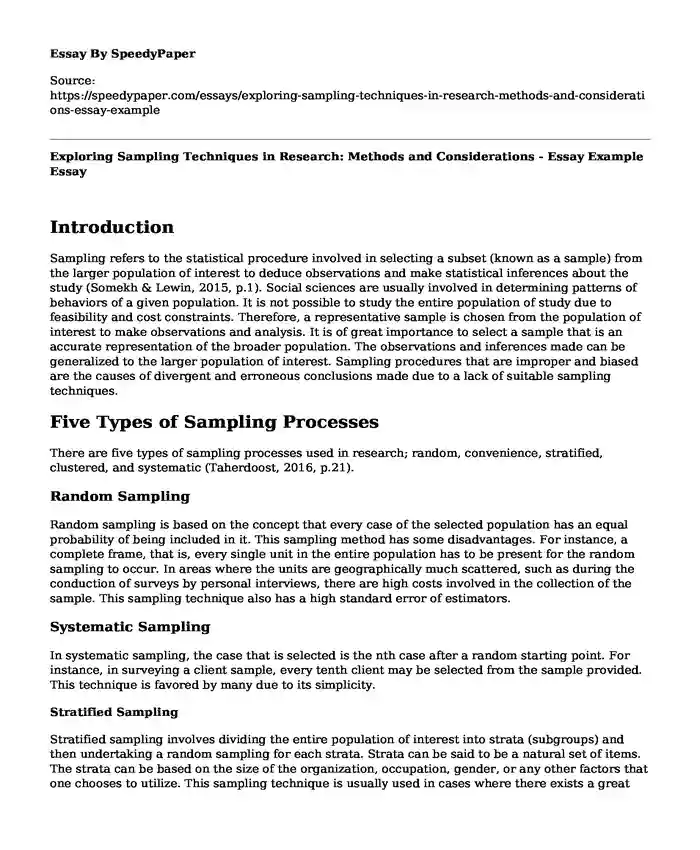Introduction
Sampling refers to the statistical procedure involved in selecting a subset (known as a sample) from the larger population of interest to deduce observations and make statistical inferences about the study (Somekh & Lewin, 2015, p.1). Social sciences are usually involved in determining patterns of behaviors of a given population. It is not possible to study the entire population of study due to feasibility and cost constraints. Therefore, a representative sample is chosen from the population of interest to make observations and analysis. It is of great importance to select a sample that is an accurate representation of the broader population. The observations and inferences made can be generalized to the larger population of interest. Sampling procedures that are improper and biased are the causes of divergent and erroneous conclusions made due to a lack of suitable sampling techniques.
Five Types of Sampling Processes
There are five types of sampling processes used in research; random, convenience, stratified, clustered, and systematic (Taherdoost, 2016, p.21).
Random Sampling
Random sampling is based on the concept that every case of the selected population has an equal probability of being included in it. This sampling method has some disadvantages. For instance, a complete frame, that is, every single unit in the entire population has to be present for the random sampling to occur. In areas where the units are geographically much scattered, such as during the conduction of surveys by personal interviews, there are high costs involved in the collection of the sample. This sampling technique also has a high standard error of estimators.
Systematic Sampling
In systematic sampling, the case that is selected is the nth case after a random starting point. For instance, in surveying a client sample, every tenth client may be selected from the sample provided. This technique is favored by many due to its simplicity.
Stratified Sampling
Stratified sampling involves dividing the entire population of interest into strata (subgroups) and then undertaking a random sampling for each strata. Strata can be said to be a natural set of items. The strata can be based on the size of the organization, occupation, gender, or any other factors that one chooses to utilize. This sampling technique is usually used in cases where there exists a great deal of variation in the population. The primary purpose of this process is to ensure that every stratum has been represented adequately.
Cluster Sampling
Cluster sampling refers to when the entire population of the study is divided into groups or clusters. Consequently, a random sample is taken from the clusters, whereby all are used in the final sample. This sampling method is favored by many as it has advantages to the researchers with subjects fragmented across a vast geographical region since it saves money and time. There are three main stages of cluster sampling; selecting the cluster grouping frame like geographic region or company, numbering every cluster, and finally selecting the sample using random sampling.
Convenience Sampling
Convenience sampling entails selecting participants who are easily and readily available ((Taherdoost, 2016, p.22). It is important to note that this method is usually favored among students since it is not expensive, and it is also an easy option compared to the rest of the techniques. The convenience sampling can help in overcoming numerous limitations that are associated with research. For instance, using family members or friends as part of the sample is more comfortable than targeting unknown persons.
Definition of Target Population
The target population refers to the entire collection of individuals or entities from which a research sample might be drawn (Taherdoost, 2016, p.21). Therefore, the target population defines the entities for which inferences and findings of the research are supposed to be generalized.
Sampling Frame
A sample frame is the set of the subset of the entire population selected from the targeted population (Martínez-Mesa, González-Chica, Duquia, Bonamigo & Bastos, 2016 p.327). The sampling frame consists of all the entities in the population that can be sampled and may include; institutions, households, or individuals. Determinants of a suitable sampling frame include; inclusion of all entities in the target population, exclusion of all entities not in the target population, and contains accurate info that one can use to contact the selected individuals.
Selecting a Sampling Technique
Selecting a suitable sampling technique involves:
- Listing the research goals and objectives
- Identifying potential sampling techniques that might be effective to achieve those goals
- Testing the capability of each of the methods to achieve each goal
- Choosing a sampling technique that executes the job best by achieving the set goals.
- Executing the Sampling Process
- Define the target population clearly
- Select the sampling frame to be utilized
- Choosing the sampling technique
- Determination of the sample size
- Data collection
- Assessment of the response rate
Bibliography
Martínez-Mesa, J., González-Chica, D.A., Duquia, R.P., Bonamigo, R.R. and Bastos, J.L., 2016. Sampling: how to select participants in my research study? Anais brasileiros de dermatologia, 91(3), pp.326-330. DOI: http://dx.doi.org/10.1590/abd1806-4841.20165254
Somekh, B. and Lewin, C. eds., 2015. Chapter 8. Sampling. Research methods in the social sciences. Sage. https://courses.lumenlearning.com/suny-hccc-research-methods/chapter/chapter-8-sampling/
Taherdoost, H., 2016. Sampling methods in research methodology; how to choose a sampling technique for research. How to Choose a Sampling Technique for Research (April 10, 2016). https://dx.doi.org/10.2139/ssrn.3205035
Cite this page
Exploring Sampling Techniques in Research: Methods and Considerations - Essay Example. (2023, Nov 05). Retrieved from https://speedypaper.net/essays/exploring-sampling-techniques-in-research-methods-and-considerations-essay-example
Request Removal
If you are the original author of this essay and no longer wish to have it published on the SpeedyPaper website, please click below to request its removal:
- Free Essay about China
- Free Essay on Problem-Solving Techniques
- Inconsistencies and Tensions of Marxism and Communism, Essay Example
- Essay Sample: Nonverbal Communication in Native American's Culture
- Date:Notification of a Lawsuit - Yemen Lawsuit
- Essay Example on 9/11 Memorial Museum Ethnography
- Essay Sample on The Official Language of the United States
Popular categories





